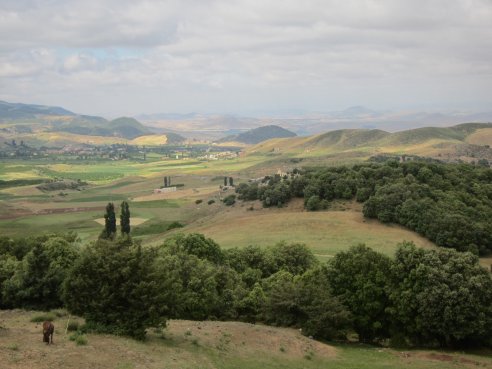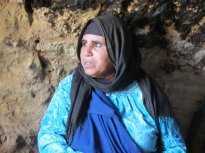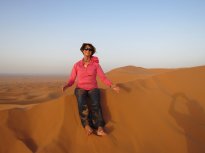The Majesty of Desert and Mountains - From Fes to Marrakech
The next five days of our exploration of Morocco are probably the most memorable of our entire trip. We had booked a five day 4X4 trip with a driver, and were able to get another passenger, a young Korean guy named Kiho, currently studying in the US, to bring the cost down. The trip included all accommodation, meals and transportation. Ibrahim, our driver, originally came from the desert. His driving skills were excellent and he spoke passable English. We followed an itinerary that included the cultural and historical highlights along the road to and from the Sahara, stops for photo ops and breaks at "tourist safe" restaurants.
It is difficult to find the words that describe the feelings I had as we travelled from the dry grasslands outside Fes, through mountain passes with jagged peaks towering above, to the terra-cotta reds of the desert sand and cliffsides of the High Atlas Mountains, and finally to the lush green of the Marrakech valley. The landscapes of Morocco are stunningly beautiful (hence the many attached photos--it was hard to choose) and impressed me in so many ways. As well, the people are simple and warm, always asking if we were happy because it would make them happy. Here are some highlights that are forever engraved in my mind:
The diversity of landscapes and how quickly it changed
Beginning in the cultivated fields of Fes, we quickly moved into the the rock-strewn slopes, grasslands, plateaus and valleys of the middle Atlas Mountains. The terrain constantly changed. We would inch our way up a switchback road carved out of the rock, round a corner and find ourselves suddenly in lush green forests of cedar. At one point we took a short break at a bizarre (and cold/windy) "tourist" town that had been developed in the style of a Swiss mountain village (it snows a few months per year and there is a ski resort nearby --who knew?!). We passed a grove where Barbary apes congregate to feed off tourists--a very unfortunate situation as these animals, which are more like monkeys, are an endangered species and their disappearing habitat along with their unnatural relationship with humans (i.e, no fear) are threatening their existence. Shortly after this, as we gained altitude, the terrain becomes more stark, dry and "lunar". In the plateaus, the grasslands go on forever, devoid of habitation except the occasional abandoned nomad hut. The dusty and dry desert landscape seems uninhabitable until the ground drops into a gorge and a lush green "river" of trees provides shade and sustenance for hardy desert folk.
As we followed the narrow winding road through the High Atlas mountains towards Marrakech, magnificent vistas continued to open up before us. Many times I fought fatigue, not wanting to close my eyes in case I missed anything new. And " Wow!" came inadvertently out of my mouth too many times to count.
Nomad families with begging children and their simple, difficult lifestyle
Nomads in Morocco are families that move seasonally with their flocks of goats or sheep to uninhabited public land in mountain passes and plateaus. They put up tents or construct simple wooden shelters. Often with no medical care, modern technology or access to education, they live a simple but harsh life. The government tolerates them and allows them to use the land as grazing areas but turns a blind eye when it comes to assistance. There are some charitable groups who focus on helping these people but it is their way of life and difficult to change. We stopped at one viewpoint, in an isolated mountain pass, for photos of the distant snowcapped mountains and a family of nomads immediately appeared. The grandmother stood quietly in the background as two young girls between 6 and 10 years old began to beg for money from us. I asked Ibrahim to find out why the girls weren't in school. They told him it was too far. He sadly explained that these girls would go on to get married young and live the nomad lifestyle while they raised a family. I decided that I wanted to give some books and writing materials to a needy family and the opportunity arose for just that.
After visiting the beautiful Dada and Todra gorges, we took a rough track through the lunar landscape (stunning scenery!). On both sides of the road were steep cliffs and we could occasionally see caves dotting the slopes. We stopped at one cave cluster to meet a nomad family. This family was accustomed to foreign visitors, regularly receiving clothing and financial aid while living a nomadic lifestyle tending their herd of sheep. The grandparents, who were looking after the two youngest grandchildren invited us into the cave for tea. We were told the rest of the family was out with the herd or gone to the nearest village (15K) for supplies. The young boys (around 2-3 years old) were adorable and shy, and I tried to connect with them by making animal noises. They eventually came around and we had fun making barking and clucking sounds together! After tea, I gave the grandparents some printing and alphabet books that I had picked up at a local market the day before. They seemed grateful and the older of the two boys was thrilled when Ibrahim helped him "form" some Berber letters with a shiny new pen.
Ksars, kasbahs and the people
Many times we passed a cluster of large buildings surrounded by a wall and accessed by a stone archway. Often the buildings were in a state of ruin and appeared deserted. Ibrahim explained that these were called ksars and that, while many were abandoned towns, a large percentage were still lived in. As evidence, we could see electrical lines running into many buildings. We pulled up to the front of one "ksar" and ventured through its gate. It was eerie to walk through the silent, dark and narrow paths. Occasionally we passed by a door that had been painted and a lock installed, so we knew that someone lived there. At one corner we saw an old man huddled in an alcove with certain intimate body parts exposed…we politely averted our eyes and he got up to follow us. Then two young men approached us. One tried in broken English to ask us where we were from. Ibrahim had a conversation with them and we found out that he was learning a bit of English at school and he wanted to be a guide for tourists. Ibrahim wisely told him to work hard and he could do whatever he wants to do in life. I hope the message sunk in as he was a personable young man and seemed motivated to go beyond the primitive confines of the ksar.
The difference between a ksar and a kasbah, Ibrahim explained, was that although they look alike in many ways (and can often both be in a state of ruin), a kasbah was built as the dwelling for one rich family while a ksar housed many. Kasbahs today fall into four categories: 1) abandoned and disintegrating, 2) still lived in by a wealthy family, 3) made into a museum, or 4) renovated into a hotel. We saw examples of all four. Some of the museums and hotels were stunning, and we explored several that had been preserved with the original architecture and mosaics.
The zen of the desert
It is difficult to describe the expansiveness and beauty of the sand dunes of the Sahara. As we drove towards the Berber camp, following only tire tracks through a harsh and seemingly endless landscape, I wondered how people could exist there. Somehow people do. Ksars spring out of nowhere, and when it seemed as if there could be nothing but sand ahead, a sign would sudddenly appear, directing you in a different direction towards a village or hotel. Closer to our final destination, we could see what appeared to be huge palaces on the horizon.These were the luxury hotels that many tourists booked into. Just before our arrival, the sand dunes loomed. Surreal!
Our desert tent camp accommodated about 24 people and consisted of a lounge, dining area and two rows of sleeping tents made up of tarps and heavy rugs. Inside our tent was a double bed, chair and a small light powered by a switch. The floor was covered by a rug and the bed was layered with wool blankets. It was hot and stuffy inside but we were told it would be cold at night. And that night, despite the drop in temperature, the howling wind and a strange-looking and large insect that crawled under the bed, we were comfortably warm and slept well. The food that was served by the Berber staff, all men in traditional desert garb, and the campfire and music provided afterwards, were very memorable.
But at the top of my list of best experiences ever was the camel ride up into the dunes, and watching the sun set on the sandy horizon. Riding a camel was easier than I thought (easier than an elephant!) and the placid animals, led by two young Berber men, effortlessly took us up and over a few dunes to a high point. We were instructed to get off the camel and follow the guides to a flat area where a blanket was laid. Sitting on the blanket with a full view of the sun sinking into the sand and the colours and shadows of the dunes intensified around us was sublime.
But we were not quite at the highest "peak" in the dunes, and I was itching to see what was on "the other side" so asked if we could walk to the top. With permission given and the sun very low on the horizon, we walked and perched ourself on the ridge. And on the other side…..more dunes, of course! The wind was howling and sand was blowing, but it was exhilarating and I felt immensely happy! Just before we walked back down to meet up with the patiently-waiting camels, a group of Berber guides and a few tourists (from North America) came scrambling up a slope with…a snowboard and boots! A guy from San Fransisco was determined to "ride" the slopes of the dunes, and we watched in amusement as he failed miserably to get enough speed to carve a turn. Someone had the brilliant idea to use the board as a toboggan, so we were offered the "fast" way down to our camels. I grabbed hold of one Berber guy, we were given a big shove and off we went! Sliding down a dune in the Sahara on a snowboard…priceless memory! It took about a week to get the sand out of our belongings….both personal and physical!
Photos
- coming out of Fes
- The barren landscape of the plateaus in the Middle Atlas mountain
- ksar...is it inhabited? We''ll never know
- No washing machines...when it rains,its laundry day at the stream
- Potential tour guide... what a nice young man
- contemplating dinner at the local town market
- at a local market
- Full of Berber Pizza
- Lining up for the tourists
- Our home in the desert for the night
- abandoned dwelling in the desert
- The quintessential desert photo!
- Our Berber guide at the desert camp
- ""One of these things does not belong..."
- In the dunes of the Sahara and on top of the world!!!!
- colours and shapes--the beauty of the dunes of the Sahara desert
- abandoned "Ksar" in the Sahara
- with "Omar" in the Sahara
- We passed by many towns where lush green palm forests flowed through the valley like a river
- The type of rock is called "Monkey Fingers"
- One of the many narrow and beautiful gorges we passed through
- on our way to the dunes to watch the sunset
- Nomad cave woman








